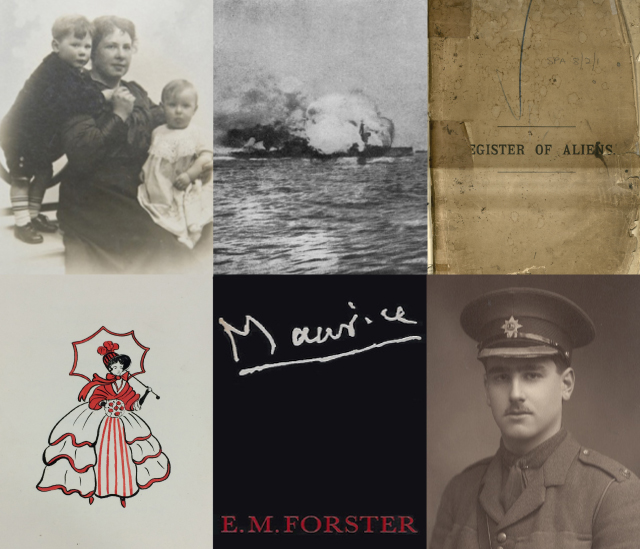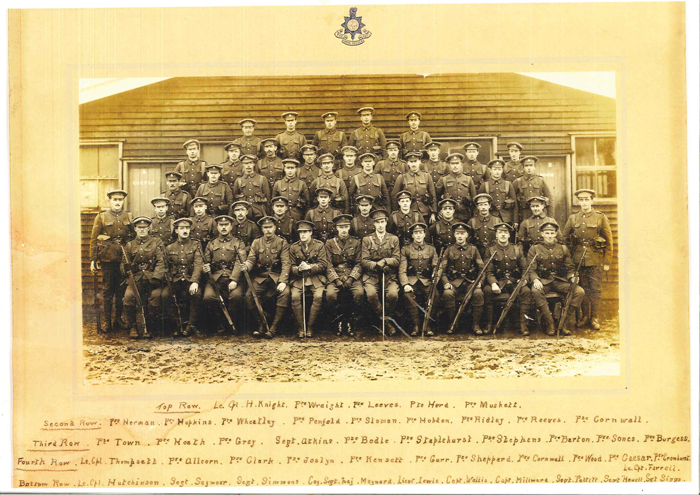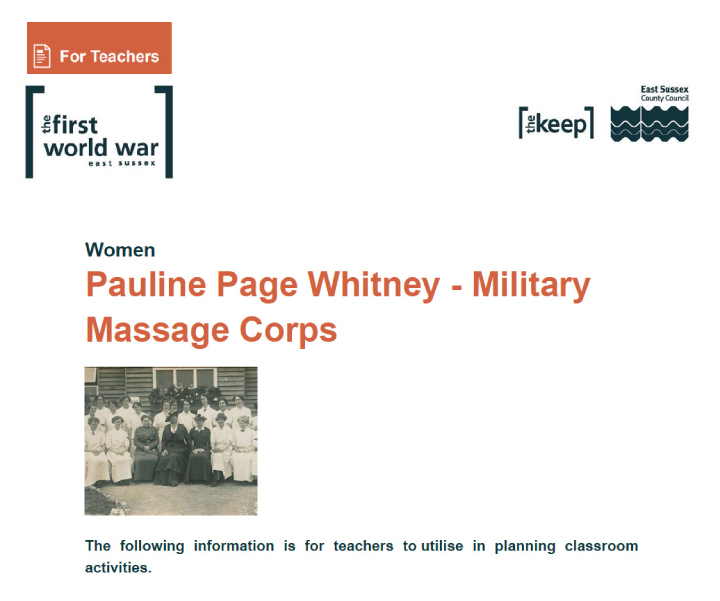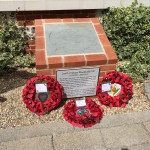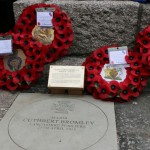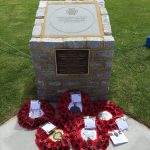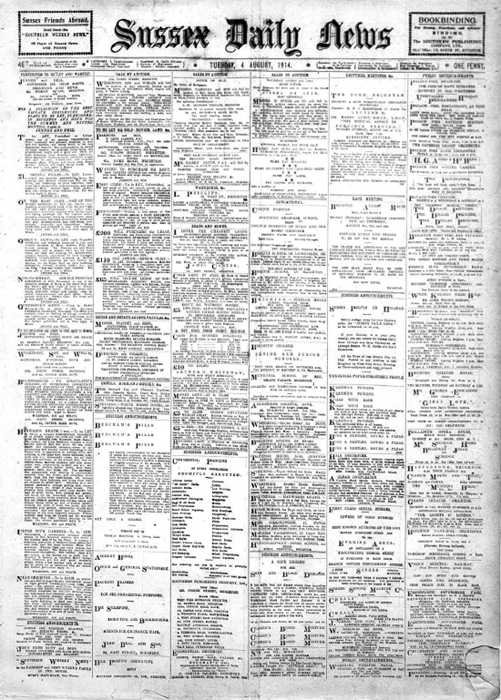On 4 August 2014, at the start of the First World War centenary events, the East Sussex First World War project website went live. As the project reaches its 2nd anniversary, we look back on the last year.
The first year of the East Sussex First World War Project had been a huge success. Over the first 12 months we published over 130 stories and events relating to the First World War in East Sussex, with over two-thirds of them submitted by members of the public, local community groups, historians and museums. We had also begun the process of publishing, on a monthly basis, First World War editions of the Eastbourne Gazette, Eastbourne Chronicle, Hasting & St Leonards Observer, and the Hastings & St Leonards Pictorial Advertiser.
For the 2nd year of the project it was important to maintain the existing momentum but also to start using the material we had gathered in different ways.
Stories, Events and Statistics
Over the 2nd year of the project we have published 35 stories and events, with 62% of them submitted by the public. More than 170 stories and events have been published on our website since the launch of the project.
The website itself has been viewed over 52,000 times in the last twelve months. Across its lifetime, the website has now been viewed over 112,000 times.
To mark Women’s History Month in March 2016, we showcased all our stories about women during the First World War on the front page of our website and through our Twitter account. Over the course of that month, we also published several new stories. For the entirety of March we had over 4,500 page views. On International Women’s Day (8th March) our website was viewed 227 times.
2016 has been an important year for national commemorations of the First World War and we have featured stories on the battles of Verdun, Jutland, and the Somme. Additionally, it has also been the 100th anniversary of the Battle of the Boar’s Head; a battle were hundreds of men of the 11th, 12th, and 13th Southdowns Battalions of the Royal Sussex Regiment were killed in action during a diversionary attack the day before the Battle of the Somme. The local significance of this battle was an important part of our plans for the 2nd year of the project.
On 30 June, we highlighted many stories examining the men of Lowther’s Lambs and drawing attention to the heroism of Nelson Carter VC who lost his life at the battle. The story on Nelson Carter was written by Michelle Pollard of Langney Primary School in Eastbourne who, along with the children there, had been researching the life of Nelson Carter.
Between 30 June and 1 July, we received a total of 3,236 views to our website, which at the time made up 9.8% of our total website views for 2016, including 1,822 views of our story about the Battle of Boar’s head. 87.1% of these views were from users new to the website.
One of our proudest achievements this year has been to spread awareness and information about the events of the Battle of the Boar’s Head, 100 years after it happened.
Recording Remembrance
49 memorials have been recorded on our sister site, Recording Remembrance, in the past year. The project, run by East Sussex Historic Environment Record, aims to ensure that there is a lasting record of war memorials in East Sussex by encouraging members of the public to submit details of memorial’s inscriptions, location and condition. The number of small, local memorials in Sussex makes the role of volunteer contributors vital – sometimes they are as simple as a plaque on a village hall, or a stained glass window.
One great piece of local history that volunteers have uploaded on the site this year is a small roadside memorial at Herstmonceux, dedicated to a young Flying Officer named Peter Crofts, who was shot down during the Battle of Britain and was killed as he parachuted to the ground. These kind of small memorials, that tell important stories, are impossible to keep track of without a brilliant helpful network of volunteers.
Educational Resources
From the start of the project it has always been important for us to find ways to assist in the education of local school students in the First World War. At the end of our first year we had enough stories of different topics and focuses to begin building educational resources.
On 1 October 2015, we launched a number of educational resources on our website for both teachers and school students. These resources are combined into three groups; soldiers, women, and children. All of the information within them relates to people and places within East Sussex and helps ensure that the next generation can understand the effect of the war on their communities.
We selected nine different stories and rewrote each one into a resource pack for teachers. These packs contained images, information on dates and context, key questions for students, and a condensed version of the original story from our website. We then rewrote these stories for school children. We kept the images and presented the information from each story so it was easy to understand and use and added questions for the students based on the material they’d read.
All of these educational packs are free to download from our website and we are in the process of introducing new categories of stories to expand these resources.
Victoria Cross Memorial Paving Stones
A few days before our 1st anniversary, on 30 July 2015, we assisted in the planning, installation and unveiling of a Victoria Cross Memorial Paving Stone in Lewes for 2nd Lieutenant Sidney Woodroffe. On 16 August 2015, we then unveiled a Memorial Paving Stone in remembrance of Seaford resident, Major Cuthbert Bromley.
These two events have since been followed by the unveiling of a paving stone on 2 July 2016 in Eastbourne, to commemorate the bravery of Company Sergeant Major Nelson Carter, who was posthumously awarded his Victoria Cross for the bravery he showed rescuing wounded men at the Battle of the Boar’s Head.
By helping install and unveil brand new war memorials that commemorate soldiers from East Sussex, we have ensured that the legacy of their sacrifices will exist in their hometowns beyond the end of the First World War Centenary.
- Sidney Woodroffe VC – Commemorative Paving Stone Ceremony – Lewes 30/7/2015
- Cuthbert Bromley VC – Commemorative Paving Stone Ceremony – Seaford 16/08/2015
- Nelson Carter VC – Commemorative Paving Stone
To help showcase the planning process from inception to unveiling of these stones we have documented the planning and delivery of the Nelson Carter ceremony.
Sussex Daily News
The Keep archives near Falmer hold comprehensive microreels of the Sussex Daily News. The four newspapers we have already published on our siteallow viewers to follow the course of the war and everyday life in East Sussex on a week by week basis. We realised that by publishing the Sussex Daily News it would be possible for viewers to follow the war day by day.
Developing this additional resource was no small proposition. The four newspapers we have already digitised were hugely ambitious for a project of our kind; such attempts are normally reserved for organisations and institutions such as the British Library, the National Newspaper Archive, and the National Library of Wales. As a result we were the first project of our kind to offer such a large and varied collection of newspapers online.
But, we had decided that the First World War Centenary offered us an opportunity to dream big.
Two University of Sussex history students helped us to begin the long process of digitising the microreels held at The Keep. These two dedicated workers visited The Keep every Monday, the day it is closed to the public, for several months and then also began the process of ordering the images into recognisable editions of the newspapers. This was an arduous process. The images on the microreels themselves varied dramatically in quality and some reels could not be scanned at all. However, we also maintained the view that it was best to make use of what we could and explain that which we could not.
Once these two students had completed their task, we passed the files onto another history student at the University of Sussex, and she began combining thousands of images into PDFs for each edition of the newspaper.
After many months of hard work we are now in a position to begin releasing editions of the Sussex Daily News.
The collected and digitised copies of these five newspapers on our website may well be one of our finest achievements to date.
Feedback
We have always believed that the primary purpose of our project has been to provide the people of East Sussex with a central hub for learning about the First World War. To achieve this we have published dozens of stories and events from members of the public and from different community and historical groups.
To mark our 2nd anniversary here is some of the feedback these people have given us along the way:
Although I do not live in Eastbourne I was born there and continue to be a member of the Local History Society and carry out research resulting from enquiries. I have also written a book, nearing completion ready for publication, on the history of the pubs in Eastbourne, and I am co-editing another on the many street names, past and present, of Eastbourne. As such, my research has sometimes had to wait for a visit to Eastbourne and to the library where I have trawled through the microfiche copies of the paper. Having these digitised newspapers has helped, as the papers have provided several pieces of information for the books as well as details to help in responding to enquiries such as Shackleton’s visit to Eastbourne in August 1914 and also Gustav Hamel’s visit in February 1914. – Alan Smith, Member of the Eastbourne Local History Society
During the span of our The Boys on the Plaque WWI themed project in Brighton, and on into a new project ‘The Orange Lilies – Brighton and Hove in the Somme‘, we’ve found the East Sussex in World War I site invaluable for the sheer breadth and scope of the information, images and resources available to the public. It’s been a great help for getting started with a new project, planning funding bids, finding relevant sources as well as offering quirky photographs and memories from across the county’s Great War history. The project team have also been very supportive, and through their work, helped to bring ours to life too!’ – Nicola Benge, Creative Director, Strike a Light – Arts & Heritage
The East Sussex in World War One project has been a valuable partner to Gateways to the First World War during this first part of the centenary. As an Arts and Humanities Research Council funded Public Engagement Centre our main aim has been to engage with and offer academic support to First World War community heritage projects across the UK. Collaborative events with Dr Chris Kempshall, First World War Project Officer, such as study days, conferences and archival training have worked very well in the South East and we are extremely grateful for his commitment, enthusiasm and willingness to share such an incredibly broad wealth of knowledge with us and our community partners. The website is an excellent and accessible resource and of great benefit to everyone across the county with an interest in FWW heritage. – Dr Sam Carroll, Community Heritage Researcher (Gateways to the First World War)
As our publication ‘From The Hands Of Heroes’ – a book for St Paul’s Cathedral celebrating its magnificent WWI altar frontal and the remarkable story of its creation – comes to fruition, I would like to extend my sincere thanks to you and The East Sussex WW1 project. Your own enthusiasm and the resources your project has extended us have been of significant value. The Keep Archives and Chailey Heritage Foundation, to whom you introduced us, have provided wonderful content that has considerably enrichened the publication; in particular the remarkable image of servicemen embroidering the actual frontal. Real archival gold dust! This, I am sure, will be enjoyed and appreciated by all those who own this important book. I wish you every success with the continuance of your valuable project and service. – Andrew Humphries, Memory Lane Media
Two years on and I’m honoured to look back having helped this project continue to reach out to residents of East Sussex. The strength of this project has been the constant commitment from all who have participated. It has evolved from an online resource that engages all ages to a platform that also physically exhibits the bravery of young soldiers at events throughout East Sussex. Since 2014, each element has been delicately highlighted to help our local history be commemorated accordingly and I’m very proud to see it go above and beyond its original intention. – Madeline Whitty, East Sussex County Council
‘Working with the images taken from the Hastings & St Leonards Pictorial has provided me with a new insight into how the war was for the people at home. I hope that the Then and Now images has done the same for people looking at them. The content of the paper has led me to create a new project, WW1 Roll of Honour. This website records the details and photographs of the people in service from Hastings, St Leonards and the surrounding area. The photographs and supporting information are a valuable social record – not only of the service the individuals provided for their country during WW1, but a bigger picture of where they lived, their relatives and what they looked like. I’m looking forward to continuing my work on both the Then and Now images and WW1 Roll of Honour’ – Kieron Pelling, Compelling Photography
‘The First World War was an event of tremendous national and local significance. Throughout the centenary, the East Sussex WW1 project has allowed people from East Sussex and beyond to discover new details about the effect of the war on this county, whilst also sharing their own stories. It is important for people to remember the sacrifices and actions of those who lived during the World War and the East Sussex WW1 project is helping achieve that.’ – Councillor Keith Glazier, Leader of East Sussex County Council
‘The East Sussex WW1 project has been a great success and source of pride for East Sussex County Council. Since the project’s earliest days, through the launch period, and now up to its second anniversary, the team behind it have worked incredibly hard with partners and residents to ensure the events of the First World War in East Sussex have been properly commemorated. The measure of its success, for me, is the level of interest and engagement is has sparked in a huge range of people about the War, its legacy and in East Sussex as a rich and fascinating place.‘ – Becky Shaw, Chief Executive of East Sussex County Council
Favourite Stories
To finish our reflection on our second year we would like to provide you with a selection of our favourite stories from the last 12 months. As our project prepares to enter its third year we are already planning new stories and resources that we would like to explore and introduce. The last two years have shown us all that there is so much left still to come. If there are any stories that you would like to see on the website or stories that you could contribute, please do not hesitate to get in touch!
Chris Kempshall – Project Officer for First World War Commemorations
From the last year I probably have two favourite stories; one produced by us and another submitted to us by a local historian.
For ‘our’ story, I’m normally drawn to those which are perhaps difficult to write, be that because of the topic, or the huge amount of information that needs to be made manageable. With this in mind my favourite internal story of the last year is on John Kipling. His father, Rudyard, is still such a famous and recognisable figure but I am unsure of how many people knew about the tragedy of his lost son John.
As a First World War historian it can sometimes be a struggle to balance the wider view of the War with its impact on individuals. The story of John Kipling is a perfect representation of the fear, the desperation, and the sadness that was felt by those at home in Britain upon hearing that their loved one could not be found.
My second favourite story of the last year comes from Louise Heren and examines British Nannies during the First World War. I’ve always believed that one of the greatest strengths of our project is the ability to give voice to the stories that do not normally get told. Louise’s story of trained British Nannies looking after Belgian children during the First World War is not only a deeply touching one it is also an example of how people found ways to live their lives whilst under the shadow of the First World War, and of those stories which are in danger of slipping out of memory if they can’t be saved and recorded now.
Lee Banner – Policy Officer, East Sussex County Council
Looking back on the last year my favourite stories are as follows:
Amelia Joel Mihlenstedt and the Alien Register – for the power and mystery of stories that get passed down through families across the generations. This story contains intrigue, some unanswered questions and talk of spies! Recording the story as part of this project allows the life of real East Sussex people to be remembered forever.
East Sussex Women’s Institute – when this project was first devised, we wanted to provide a platform to remember (in addition to the important stories that must obviously be told about the First World War) some previously hidden, unknown or forgotten individuals and organisations. This story shines a light on the everyday activities of women in the county responding to and making their valuable contribution to the war effort.
Beth McGhee – Policy Development Intern, East Sussex County Council
Looking back on the last year my favourite stories are as follows:
Homosexuality in the First World War – it feels like cheating to pick a story that I wrote, but our story on homosexuality is one of my favourites of this year because writing it granted me the opportunity to learn about a part of our social history that I previously knew nothing about. Although I had assumed, when starting my research, that I was going to discover that homosexuality was not accepted in society at the time of the First World War, what I hadn’t expected was to find that the experiences of homosexual men have practically been written out of the history of this period. Due to the threat of punishment, including imprisonment, there are scant records of homosexual men discussing their experiences. This, for me, made this story all the more important for us to write. We have made a start in recording these men’s experiences, and I hope it be added to in years to come as others continue to revise and shine a new light on the history of WW1.
Battle of Jutland – before we published this story for the Battle of Jutland centenary, I knew nothing about this event in WW1. Therefore, I’ve picked it because reading it reminded me that even some of the biggest and most famous events from the First World War, that have lived on in our national memory, can be forgotten if they’re not recorded and taught to future generations.

